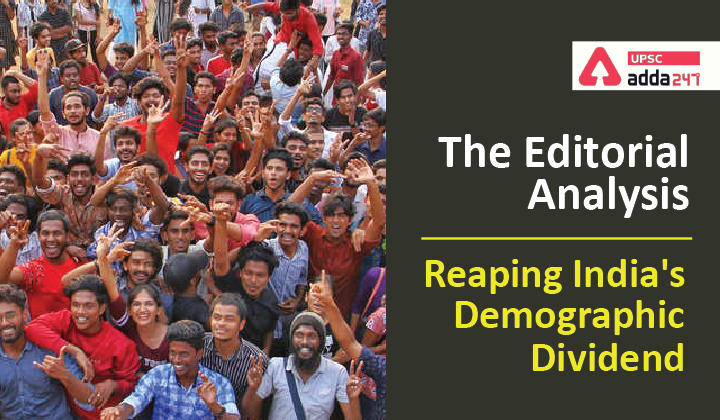Table of Contents
India’s demographic dividend: Relevance
- GS 2: Issues relating to development and management of Social Sector/Services relating to Health, Education, Human Resources.
Demography in India
- India is in the middle of demographic transition due the factors like
- falling fertility (currently 2.0),
- rising median age (from 24 years in 2011, 29 years now and expected to be 36 years by 2036),
- a falling dependency ratio (expected to decrease from 65% to 54% in the coming decade taking 15-59 years as the working age population).
- India has already started reaping the benefits of this demographic dividend. The benefits, however, are lower than the peers in Asia.
- Countries like Singapore, Taiwan and South Korea have already demonstrated how demographic dividend can be reaped to achieve incredible economic growth.
- Similar to these countries, India needs to adopt forward-looking policies and programmes to empower the youth in terms of their education, skills and health choices.
Measures to reap the benefits of demographic dividend
- Undertake an updated National Transfer Accounts (NTA) assessment:
- Using NTA methodologies by Lee and Chen (2011-12) and M.R. Narayana (2021), we find that India’s per capita consumption pattern is way lower than that of other Asian countries.
- A child in India consumes around 60% of the consumption by an adult aged between 20 and 64, while a child in China consumes about 85% of a prime-age adult’s consumption.
- The NTA data for India needs to be updated to capture the progress made on such investments since 2011-12.
- State-specific NTAs need to be calculated every year and States need to be ranked for investing in the youth.
- Invest more in children and adolescents.:
- India needs to invest more in children and adolescents, particularly in nutrition and learning during early childhood.
- Given that India’s workforce starts at a younger age, a greater focus needs to be on transitioning from secondary education to universal skiling and entrepreneurship, as done in South Korea.
- Health investments:
- Evidence suggests that better health facilitates improved economic production.
- Hence, it is important to draft policies to promote health during the demographic dividend.
- Make reproductive healthcare services accessible on a rights-based approach:
- We need to provide universal access to high-quality primary education and basic healthcare.
- The unmet need for family planning in India at 9.4% as per the latest National Family Health Survey-5 (2019-21) is high as compared to 3.3% in China and 6.6% in South Korea, which needs to be bridged.
- Education should be made gender sensitive:
- In India, boys are more likely to be enrolled in secondary and tertiary school than girls.
- In countries like Philippines, China, Japan etc., gender inequality is rather minimal.
- India too needs to follow the footsteps of these nations to reap the benefits of demographic dividend.
- India needs to increase female workforce participation in the economy:
- New skills and opportunities for women and girls befitting their participation in a $3 trillion economy is urgently needed.
- For example, a girl who passes Class 10 needs more choices to learn skills that will help her find appropriate work.
- She will need safe transport to travel to work. Finding work will likely delay her age of marriage and make her participate in the economy more productively, as also exercise her rights and choices.
- Steps can be taken like: legally compulsory gender budgeting to analyse gender disaggregated data and its impact on policies; increasing childcare benefits, and; boosting tax incentives for part-time work.
- It is predicted that if all women engaged in domestic duties in India who are willing to work had a job, female labour force participation would increase by about 20%.
- Address states diversity:
- Southern States, which are advanced in demographic transition, already have a higher percentage of older people.
- The differences in age structure reflect differences in economic development and health that need to be bridged by a forward-looking policy.
- New federal approach to governance reforms:
- A new federal approach to governance reforms for demographic dividend will need to be put in place for policy coordination between States on various emerging population issues such as migration, ageing, skiling, female workforce participation and urbanisation.
- Inter-ministerial coordination for strategic planning, investment, monitoring and course correction should be an important feature of this governance arrangement.
Also Read:





 TSPSC Group 1 Question Paper 2024, Downl...
TSPSC Group 1 Question Paper 2024, Downl...
 TSPSC Group 1 Answer key 2024 Out, Downl...
TSPSC Group 1 Answer key 2024 Out, Downl...
 UPSC Prelims 2024 Question Paper, Downlo...
UPSC Prelims 2024 Question Paper, Downlo...
